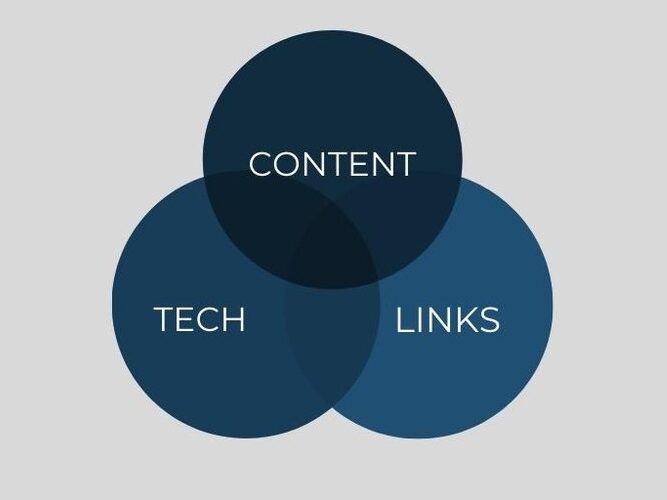Last Updated on May 21, 2024 by
In the industry of search engine optimisation (SEO), automatic link building tools have emerged as a crucial asset for website owners and content creators. These tools simplify the process of creating internal links, which are links from one page on the same domain to another page on that domain. Internal linking is a significant element of a strong SEO strategy as it can influence search engine rankings, improve site navigation, and enhance the user experience.
A robust internal linking structure allows users to navigate a website more effectively, leading to increased engagement, lower bounce rates, and a more coherent content strategy. Search engines favour websites that provide a good user experience, and a logical, internal link infrastructure can signal to search engines that the website is a valuable resource. This is where automatic internal linking tools come into play, providing sophisticated solutions that can intelligently link related content within a website.
These tools can scan a website’s content to identify relevant keywords and suggest or even autonomously insert links that aim to keep readers engaged with the website’s content. By leveraging algorithms and, in some cases, artificial intelligence, these tools can considerably reduce the time and effort involved in manual linking. As a result, they empower website managers with the means to create a more dynamic and accessible website architecture.
Automatic Link Building Explained
Automatic internal linking is a systematic approach to enhancing a website’s structure by interlinking web pages using specialised tools. These tools strategically place hyperlinks within content, connecting to other relevant pages within the same domain.
Concepts and Definitions
Internal linking refers to the process of linking one page to another within the same website. This is typically done to provide additional reading options, to improve the structure of a website, or to boost a page’s visibility in search engines. Automatic internal linking involves the use of software or online services to facilitate the linking process without manual intervention.
Benefits of Link Building
Internal linking benefits a website in several ways:
- User Experience: It guides users through the website, leading to enhanced navigation.
- SEO Enhancement: Internal links are used by search engines to understand content relationships and site architecture.
- Redistribution of Authority: Links pass value across the site, which can improve page authority and rankings for all linked pages.
How Automatic Linking Tools Work
Automatic linking tools evaluate content textually, understanding its context to generate relevant links. They typically work by:
- Scanning Content: They review the website’s content to identify keywords and topics.
- Matching Patterns: The software then matches these keywords with existing pages and posts.
- Creating Links: Depending on predefined rules or algorithms, the tool automatically inserts hyperlinks in the text, aligning with relevant in-site content.
Features of Automatic Link Building Tools
Automatic internal linking tools are designed to streamline the SEO process by effortlessly connecting various pages within a website. These tools feature algorithms for linking suggestions, a user-friendly interface, integration capabilities with popular content management systems, and options for personalisation.
Link Suggestion Algorithms
Automatic link building tools employ sophisticated algorithms that analyse content to suggest the most relevant links. They identify key phrases that match other pages within the site, ensuring that links are contextually appropriate and beneficial for SEO purposes.
User Interface Design
The user interface of these tools is crafted to be intuitive, allowing users to manage internal links efficiently. With a straightforward layout and visual cues, the interface enables quick modifications and adaptation to individual workflows.
Integration with Content Management Systems
Seamless integration with existing content management systems (CMS) is a pivotal feature. These tools can often plug directly into platforms like WordPress, facilitating automatic linking without the need to alter existing publishing processes.
Customisation Options
Variety in customisation options allows webmasters to tailor the internal linking strategy to their needs. They can set rules for link density, anchor text variation, and exclusion of certain pages to maintain the natural flow and user experience of the site.
Choosing the Right Internal Linking Tool
The efficiency of your website’s internal linking structure is pivotal for SEO, user navigation, and overall site health. Selecting an appropriate tool can be a complex decision that hinges on specific requirements and goals.
Assessing Your Needs
Before one begins their search, identifying the scope and scale of the website is critical. The size of the site and the frequency of content updates will determine the robustness required. One should also consider if the tool needs to support a single site or multiple domains.
Comparison of Popular Tools
A variety of automatic link building are available, each offering unique features. For instance, Linking Tool Clearance might be known for its cost-effectiveness, while Linking Machine Sold Direct provides fast shipping options for physical devices. To glean the best results, comparing tools like these side by side can bring clarity to their respective functionalities and limitations.
Security and Privacy Concerns
Ensuring data protection should be at the forefront when implementing a new tool. The chosen solution must adhere to data privacy regulations and should not compromise the site’s security. One should look for references to encryption standards and compliance certifications within product documentation.
Cost Analysis
The cost of automatic link building tools can vary significantly. It can range from one-time purchases to recurring monthly or yearly subscriptions. Budget constraints and ROI expectations need to be balanced against the functional benefits of the tool. It’s crucial to consider not only the upfront costs but also any potential costs for expansions, upgrades, or additional features in the future.
Implementation Strategies
Effective implementation of an automatic internal linking tool necessitates a structured approach encompassing planning, precise execution, and ongoing monitoring for optimal performance.
Planning and Preparation
Before integrating an automatic link building tool, it is crucial to determine the specific goals it should achieve, such as improving site navigation or boosting SEO efforts. A comprehensive audit of the existing content and structure is necessary to identify key areas for improvement. Preparation should include a selection of target keywords and a thorough assessment of the website’s architecture to ensure compatibility with the chosen linking tool.
Execution Steps
The implementation phase involves configuring the linking tool to align with the website’s needs. This includes setting up the parameters for keyword matching and specifying the depth of linking. For instance, LinkBoss simplifies the process with its one-click bulk interlinking feature, allowing the user to seamlessly integrate the tool into the myriad of URLs requiring interconnection, based on semantic relevance.
Monitoring and Adjustment
After execution, continual monitoring is paramount to evaluate the impact of the internal links on user experience and search engine rankings. Tools such as the SEMrush SEO toolkit can analyze current link structures and facilitate improvements, as suggested in their analysis of automated link building strategies. Adjustments may include refining keyword selections or altering linking patterns to prevent over-optimization, ensuring the entire process complements the evolving content strategy.
Best Practices for Internal Linking
Implementing an effective internal linking strategy requires a nuanced approach that considers page relevance and natural link distribution, while also employing smart anchor text strategies and avoiding over-optimisation.
Content Relevance
When employing an automatic internal linking tool, it’s vital to connect pages that are contextually related. The tool should be sophisticated enough to analyse the content and suggest links that are pertinent, ensuring that users are guided to relevant supplementary information that directly enhances their understanding of the subject matter.
Link Distribution
Care must be taken to ensure that internal links are evenly and strategically distributed throughout the site. A central page should not hoard all the internal links; rather, there should be a healthy balance. The automatic tool should facilitate a linking structure that encourages equitable visibility for all important content, preventing any single page from becoming a silo.
Anchor Text Strategies
The anchor text—a clickable text in a hyperlink—should be descriptive and concise, giving users and search engines clear cues about the target page’s content. An internal linking tool should propose anchor texts that are varied yet relevant, steering clear of keyword stuffing, and echoing the actual content on the destination page.
Avoiding Over-optimisation
There’s a fine line between a well-optimised internal linking structure and one that is overdone. An effective tool must prevent over-optimisation by limiting the number of links to the same page and avoiding any repetitive or unnatural linking patterns that could be seen as manipulative by search engines or detrimental to user experience.
Potential Challenges and Solutions
Automatic internal linking tools streamline the process of creating links within a website, helping to enhance SEO performance. However, they can encounter specific challenges that necessitate effective solutions to maintain the integrity and usefulness of the internal linking structure.
Handling Broken Links
When an automatic internal linking tool creates links pointing to pages that no longer exist, this leads to broken links. These can be detrimental to user experience and SEO. A solution involves implementing regular scans for broken links and setting up the tool to automatically redirect or remove these links. For instance, using a link optimisation tool can greatly reduce the frequency of broken links by ensuring that all internal links lead to valid, live pages.
Managing Link Updates
As content evolves, links must be updated to reflect changes. An internal linking tool must have the capacity to identify outdated links and replace them with relevant ones. Automatic link building tools can be configured to automatically adjust links based on updated content and site structure, ensuring that they remain relevant and beneficial for SEO purposes. Automation of link updates can be a significant feature offered by tools like ClarityAutomate’s Link Optimizer, saving time and improving link accuracy.
Addressing Content Silos
Content silos occur when related content is not interlinked, potentially harming the site’s SEO structure. An automated internal linking tool should be designed to detect and interlink related content across the site. Establishing rules within the internal linking tool can ensure that thematic clusters are formed, enabling users and search engines to navigate and understand the site’s content with greater ease. Such a strategy promotes a cohesive website architecture, enhancing the overall user experience.
Case Studies
This section presents real-world scenarios demonstrating the effectiveness and challenges associated with automatic link building tools used by various enterprises.
Success
Retail Enterprise Boosts Page Rankings: A retail enterprise witnessed a significant improvement in their category page ranking following the implementation of an automatic internal linking tool. The strategy led to a 24% rise in organic traffic for their e-commerce brand by increasing deeper internal links.
Effective Linking Leads to Traffic Increase: Another example involves a company achieving a 23% increase in traffic, thanks to fast and accurate internal link implementation. This enhancement was most notable on their top sales pages, showcasing the potential of a well-executed internal linking strategy.
Lessons Learned from Failures
Improper Link Relevance: Cases have emerged where the internal links generated by automatic tools were not semantically relevant, leading to a negative impact on the user experience and site performance. Tools that fail to understand the contextual meaning of content can cause more harm than benefit.
Over-automation Pitfalls: Some businesses have faced challenges when the internal linking tools did not offer enough manual oversight, resulting in a network of links that appeared forced or unnatural. It’s essential for tools to balance automation with human judgement to achieve the best outcomes.

Future Developments
Automatic link building tools are advancing rapidly, meticulously meshing with SEO strategies to improve website navigability and coherence. The following subsections shed light on specific domains primed for evolution within this innovative landscape.
Predicting Trends
These tools are expected to become adept at anticipating shifts in user behaviour and topic popularity. Advanced predictive algorithms will likely analyse past patterns to forecast emerging topics, allowing for a more proactive approach to internal linking.
Innovations in AI and Machine Learning
Developments in AI-driven analyses will enhance accuracy in identifying contextually relevant anchor text and potential link targets. Machine Learning advancements promise a leap in understanding content semantics. This might involve self-improving algorithms that refine their recommendations over time, further increasing the efficacy of internal links.
Emerging Industry Standards
As the technology stabilises, there will probably be a consensus on best practices for AI-based, automatic link building. Expect uniform metrics for evaluating tool performance and benchmarks for optimisation, resulting in a more cohesive industry approach. This would facilitate a comparison of tools based on their efficiency and accuracy in improving site interconnectivity.


